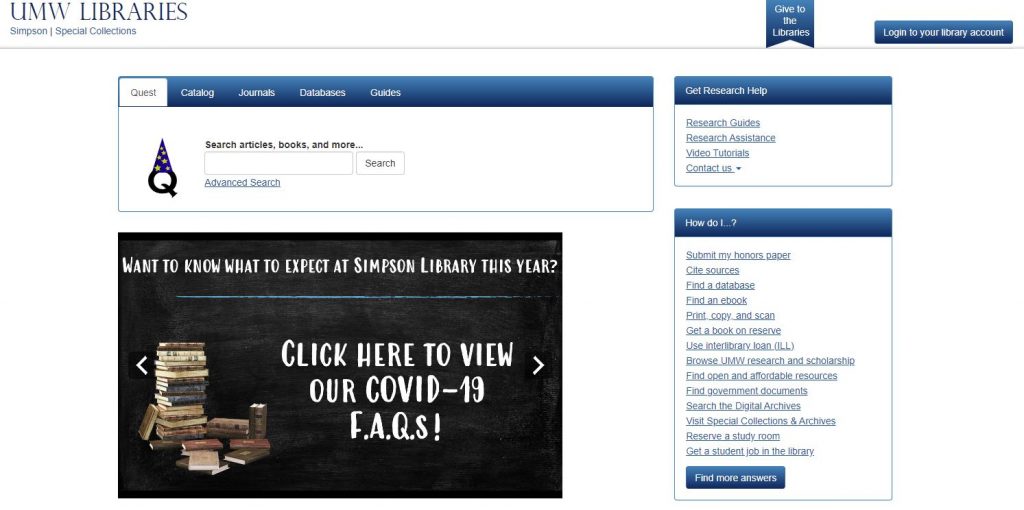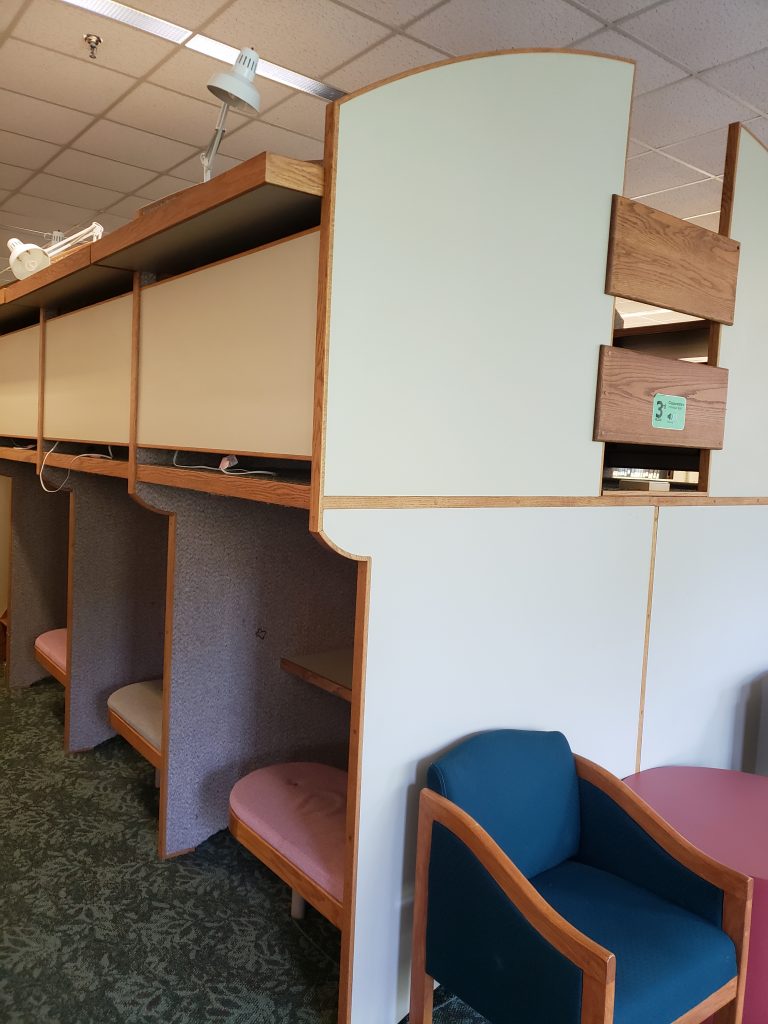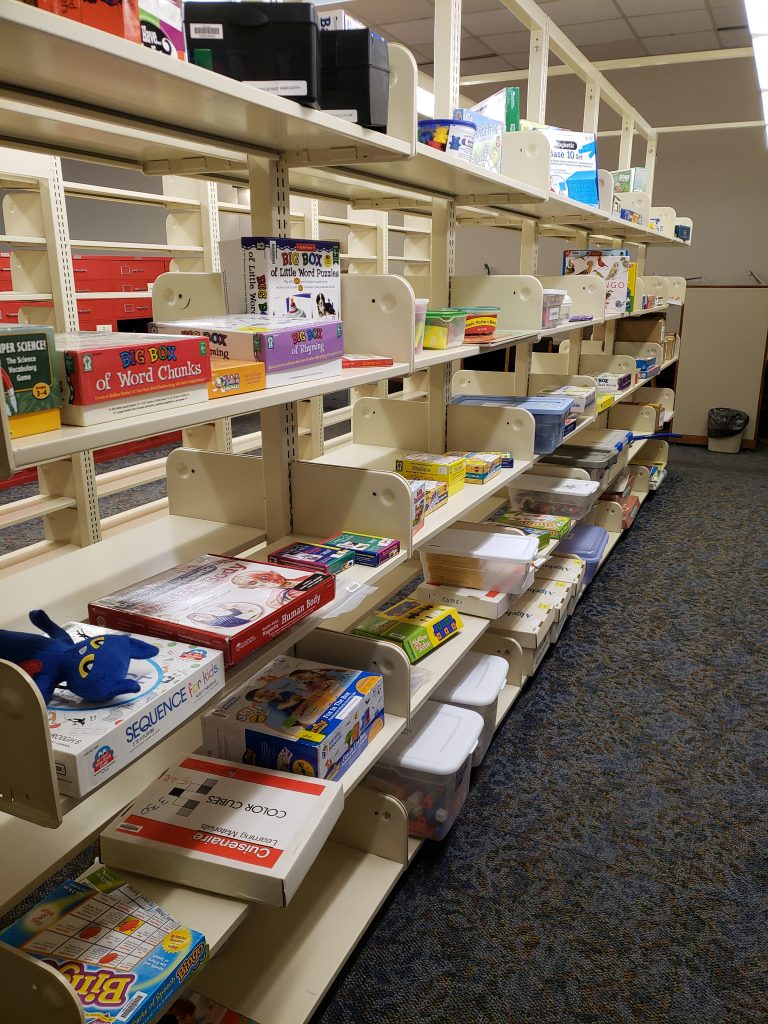I recently visited the Simpson Library at the University of Mary Washington.
Digital Access
The UMW Libraries website is incredibly comprehensive, representing both the Simpson (main) library and the Special Collections library. The Simpson Library site is very user friendly, and while I was not able to access complete details on digital catalog items without an account, the catalog is accessible to the public. The library clearly serves all faculty, students, alumni and guests of UMW. There is a wealth of topics that users may need assistance with right there on the front page, in addition to research help.

As a non-student, I was still able to access LibGuides for various courses, and all of the linked resources–so essentially, with the exception of Databases and Digital Resources, I could still get a ton of valuable information from the site if I wanted to. A staff directory is available. They specifically offer remote research assistance appointments, which I think is nice (but I’m sure adds to the decrease in actual drop-in visits). The Accessibility section of the website gives info on how those with special needs may access all areas of the collection, and gives details on which entrances/areas are wheelchair accessible, etc. I found it very comprehensive.
The Space
The library was fairly easy to find, though I did have to park in a weird spot downtown and then go on a bit of a walking adventure to get there! The entrance is kind of randomly located on a path through campus, with an unobtrusive sign on the wall, which I found surprising–you’d think the library would be more significantly noticeable. The library is three levels, with a circulation and reference desk on the main floor, Special Collections library housed on the 2nd floor, a variety of meeting rooms and “sunroom” spaces with flexible seating on the 3rd floor, and the entire collection spread over the 3 floors. There are PCs and Macs available for use on the main floor, and specifically designated computers for searching the catalog on all 3 floors. The shelving is all metal and quite tall, so wouldn’t be accessible to everyone (even me! I couldn’t reach the top shelves), but the website says they’ll provide assistance with reaching items. My favorite thing was the two-story study carrels on the 3rd floor, known as “treehouses”. It seemed like they would be fun to work in! Rubin & Rubin discuss the shift in academic libraries to becoming more patron-centered spaces, with flexible spaces for group work and available technology, with the collections being supportive rather than central (2020, p.171). This library has plenty of space for groups to work, but it lacks the current technologies (aside from computers) that would allow for digital collaborations.

Services and Intellectual Access
The library is organized using the Library of Congress system. Their (very tiny) fiction section is by genre. Wall signage lets patrons know which floor to find specific parts of the collection, and the catalog can be accessed via designated computers on every level. The shelves are labeled on the ends with LOC designations. There were a couple of promotional flyers advertising summer hours and a display in one of the conference rooms, but other than that I didn’t really see any programming advertised. I suppose you might not see as much of that in an academic library, and perhaps the summer is also a factor, but I was kind of disappointed. As far as academic services, though, you can get drop-in help or schedule an appointment with a librarian for research help. They do in-person or virtual appointments, and the librarians are assigned specific areas of the curriculum, so they are very familiar with the subjects that patrons may need assistance with. You can also get Inter-Library Loans, and they have course reserves for easily accessing required materials.
People
When I was in the library, it was completely empty with the exception of staff, who were all white. Despite a statement on their accessibility page about diversity and inclusion, I didn’t see much evidence indicating this–but I also didn’t see evidence against it, except the absence of signage in other languages. There are 18 staff members, including a variety of librarians–they even have someone assigned as a Digital Resources librarian, and one who only handles Inter-Library loans. I was particularly interested to see they have a Head of Access Services and Outreach–that sounds like my kind of job! I can see how it would be easy to get “pigeon-holed” into a position in a larger university, given how specific some of the titles were at this smaller school. I imagine the library would be busier during the regular academic year, though the librarian I interviewed with did tell me that their drop in numbers are down a lot since the pandemic started. What’s really nice is that the public are able to obtain guest library cards, so they can access services here as well.
Collections
The library has a large non-fiction and reference collection, a tiny popular fiction collection, a small juvenile/YA collection, newspapers, magazines, maps, and even microform. I hadn’t seen a Microfiche reader in quite awhile! They also have over 100,000 e-books and more than 50 databases specific to the library, with over 180 more available through the Virtual Library of Virginia collection. They also circulate a variety of games and manipulatives that support the K-12 classroom.

The Reference collection is for in-library use only, which is fairly standard. They have huge books with old prints of the Free-Lance Star (the local newspaper) and collection of Praxis study guides as well. It’s clear that this library has an academic focus, and is particularly supportive of the School of Education. They also have a Special Collections library that houses rare books, journals, and university archives. According to Rubin & Rubin (2020), “much of the library’s financial resources are devoted to databases and digital collections,” (p.170), and that is clearly evident based on my observations. While they have some books in other languages, I wasn’t impressed by the diversity of the physical collection. The website and digital resources are more inclusive.
Final Notes
As someone who enjoys libraries anyway (clearly!), I could definitely see myself studying or working in this one if I were a student at UMW. It did have a kind of outdated feel to it, but that may also be due to the fact that I work in a recently renovated library. The space felt homey and welcoming, the staff were extremely helpful, and the flexible seating/meeting places and extensive digital and physical collections were far better than what I had available at my undergraduate school. That being said, I was so impressed with their website that I can see why the library itself has seen drop-in numbers go down–it’s hard to justify making a trip to the space when you have so many digital resources at your fingertips. I will say that this visit was one more nail in the coffin as far as academic librarianship goes, at least for me, because all I could think when looking at the shelves was how much I would want to weed the collection!
Rubin, R. E. & Rubin, R. G. (2020). Foundations of library and information science (5th ed.). ALA Neal-Schuman.
Michele,
I see that you and Todd both visited the same academic space. I saw a lot of parallels in your blogs, especially the note about how it is kind of hard/weird to find at first. I think that is interesting, because you would think that a library would put out signage and make it easier for their patrons to find them. Rubin & Rubin mention that “research libraries have been profoundly affected by digital technologies that have influenced user expectation and behavior” (p.152). I can see this evidence in your thoughts about why the student visits numbers have gone down. Perhaps their amazing website is doing such a great job that students are able to access everything they need digitally and thus have less of a need to visit the actual building. 50 databases and over 100 thousand e-books is sure enough to keep anyone satisfied.
Rubin, R. E. & Rubin, R. G. (2020). Foundations of library and information science (5th ed.). ALA Neal-Schuman.
That’s really my conclusion. They’ve done such a good job offering digital resources that nobody is coming to the library, which is a shame!
Oh, great point. I wasn’t sure if it was the ghostown of the summer or if that is what we would see in the fall as well. I think I mentioned this somewhere else, but I know our library future project brings up some of these questions about the longevity of a physical space. Can a physical library survive? I think we all know on collection alone it cannot…it has to be that diversity of programming and special features that bring people in to share resources and collaborate.
Hi ! As I read your post, I got the eerie feeling that it was familiar. I wasn’t so quick to figure out that you and Todd both did the same library until I saw the treehouses which I had never heard of before (I really want to go up in one). It’s interesting that the library has computer stations that are macs and IBM pcs. I loved seeing the board game collection that people can check out – but I am guessing that it is limited to students in the education department. Do you know if they have a board game collections for students to check out? Are the board games in open stacks or are they in a separate room?
It scares me hearing about so many libraries seem deserted. I have my fingers crossed that it is because it is summer.
The board games were in open stacks! I don’t think they’re limited to education students. And I agree-the treehouses were the coolest ppart. But otherwise, this space wasn’t particularly inviting, so that may be another reason why it was empty…
I can see that having a great online resource is beneficial to the student but the actual building itself needs to rethink how best to use the space. I think the libraries are a great meeting space and perfect for study groups. Some academic libraries have a special area for students with autism because it becomes a social gathering place too. Overall, I hope academic libraries are making room for everyone to feel comfortable.
I think it’s great that the website has a dedicated accessibility section! I didn’t find anything of the sort on my tours and website sleuthing, when it really should be standard.
Ha ha ! To weed or not to weed. I always want to weed other collections but when it comes to mine I’m always, “NO, not that book!”.